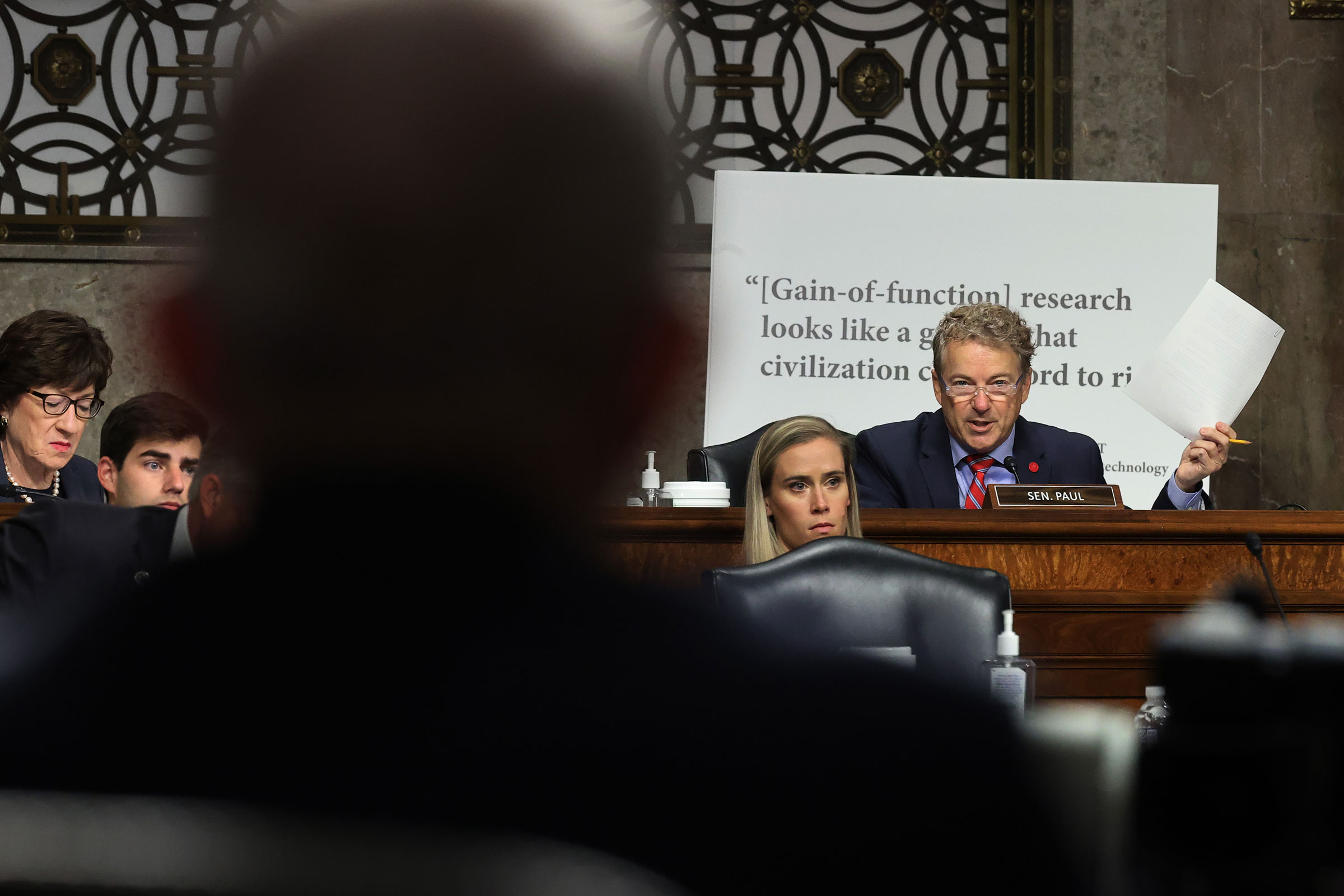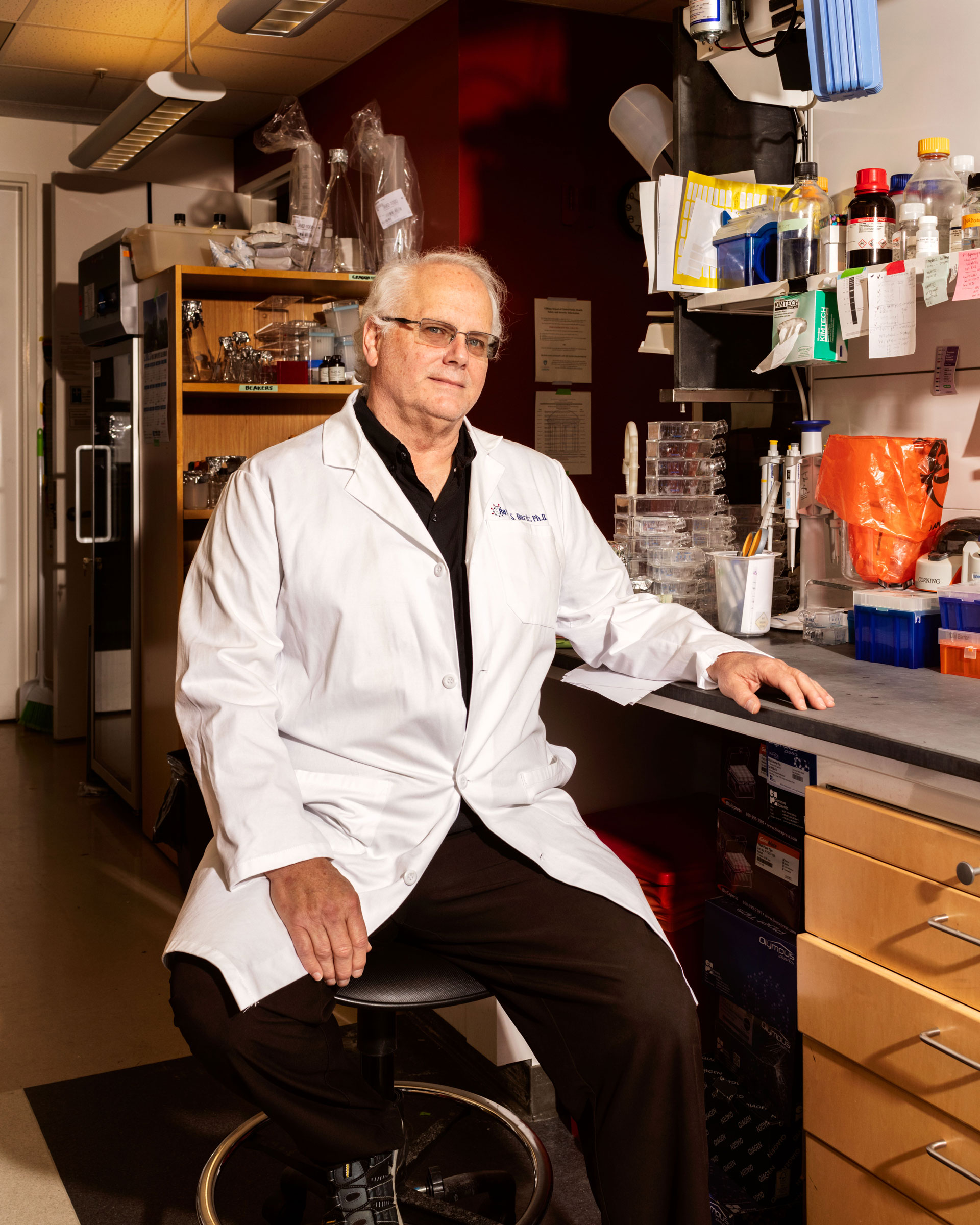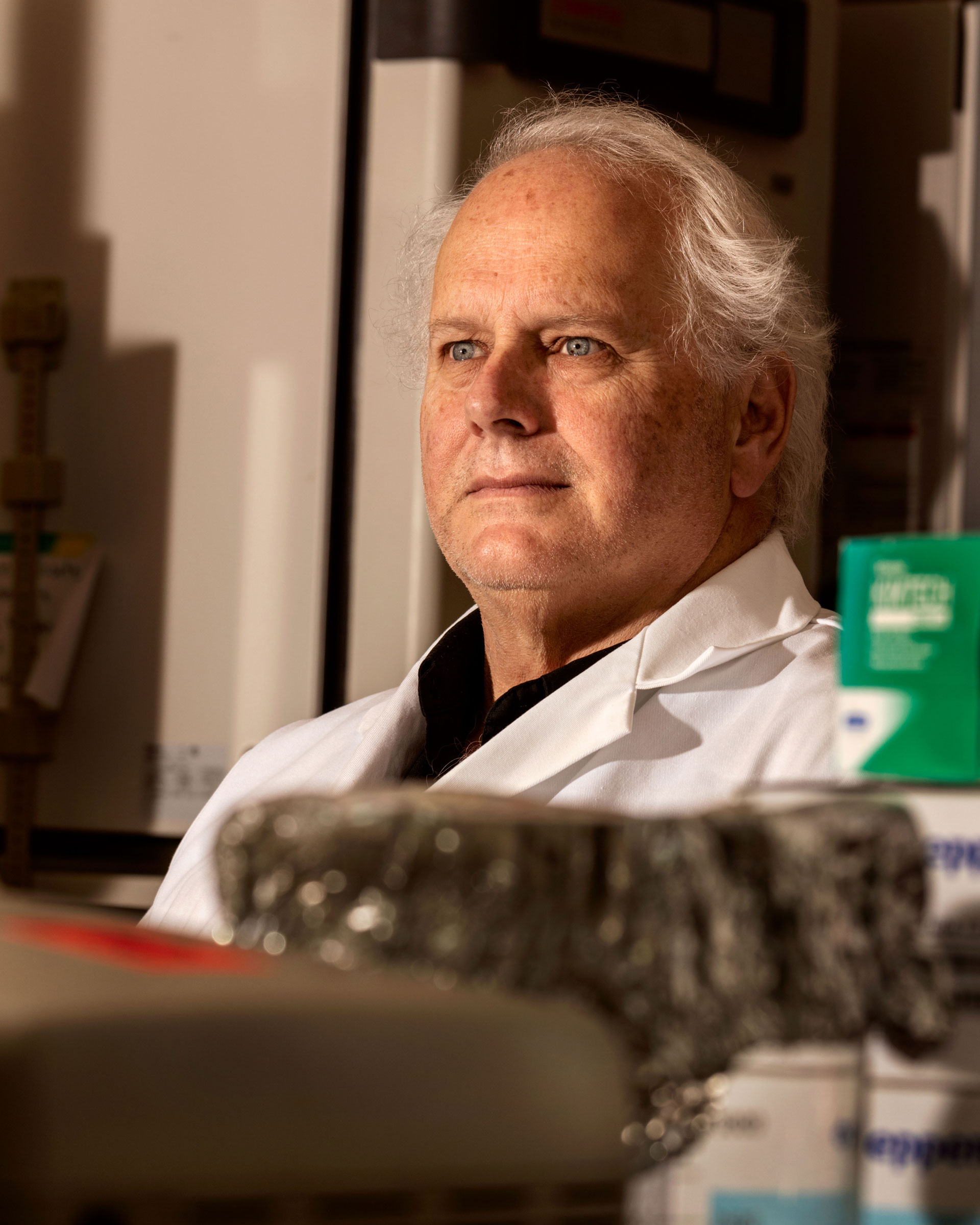Ralph Baric stepped onto the auditorium stage at the University of North Carolina, Chapel Hill, and looked out at the sparse audience that had come to hear him speak. On the large projector screen hanging behind him, the following words appeared: How Bad the Next Pandemic Could Be, What Might It Look Like, and Will We be Ready. The date was May 29, 2018.
“Well, I have to admit I’m a little worried about giving this talk,” Baric said. “The reason is being labelled a harbinger of doom.” The screen shifted, and images of the four horsemen of the apocalypse—Death, Famine, War, and Plague—came into view, next to a headshot of a smiling Baric. “This is not me,” he continued, “I’m not one of the four horsemen of the apocalypse.” Light laughter bubbled through the audience; Baric smiled. For the next 35 minutes, he laid out his prediction, with uncanny precision, of what the next pandemic would bring: a rush for bogus antiviral treatments, vast profits for companies making personal protective equipment, a global economic crash, and a rise in conspiracy theories claiming that the pandemic pathogen was designed by scientists.
When SARS-CoV-2 emerged less than a year and a half later, Baric was among the first to raise the alarm. As early as January 2020, Baric felt certain that the new virus’s spread was more akin to the flu than any of the human coronaviruses he had previously encountered. A timeline, he realized, had already been set: “The U.S.,” he says, “had three months.” By March 2020, right on the Baric schedule, the U.S. belatedly imposed wide-ranging shelter-in-place restrictions to prevent a domestic epidemic.
Baric, who has been researching coronaviruses since the 1980s, was a linchpin of the scientific response to COVID-19. He was tasked with moving potential cures—some of which he had been developing for close to a decade—out of the laboratory and onto the market. Sequestered in a state-of-the-art Biosafety Level 3 lab at the University of North Carolina, equipped with the multiple redundancies and safety features required by the U.S. Centers for Disease Control and Prevention, Baric oversaw a staff of dozens, many of whom (like Baric) practically lived at the lab.
More from TIME
He and his team were besieged by requests to support research groups across the globe who needed to run trials on SARS-CoV-2. That included developing animal models to establish the safety and efficacy of multiple COVID-19 vaccines in the early days of 2020. Baric and his long-time collaborator Mark Denison, a pediatric clinician at Vanderbilt University with a specialty in coronavirus-related diseases, also demonstrated that remdesivir and molnupiravir, two antiviral drugs originally designed for other uses, were highly effective in preventing illness; in May 2020, the U.S. Food and Drug Administration (FDA) provided emergency use authorization for remdesivir, making it the first COVID-19 antiviral on the market.
In the roughly three and a half years since the pandemic began, Baric has published over 250 peer-reviewed studies—a dizzying rate of productivity amounting to roughly half of his total output across a 40-year career. Between May 2020 and March 2023, I spoke frequently with him about his research, the successes and failures of the COVID-19 response, and his fears—and dreams—for the future.
While the COVID-19 pandemic global emergency officially ended on May 5, 2023, questions about its origins show no signs of abating. Last Friday (June 23), the Biden Administration declassified a report that revealed a split within the U.S. government on the question: five federal agencies have concluded that SARS-CoV-2 most likely spilled over into humans directly from an animal, while two others—the Energy Department and the Federal Bureau of Investigation—assert that it likely spread indirectly through a laboratory accident at the Wuhan Institute of Virology (WIV), while there was near unanimity across agencies that the virus was not manmade. The report also notes that three Chinese researchers at the WIV—including one whose work was funded by the U.S. government—became ill with an unspecified illness early in the COVID-19 outbreak (according to Chinese authorities, none tested positive for SARS-CoV-2).
Baric, who signed onto an open letter published in Science in 2021 demanding a thorough investigation of the origins of SARS-CoV-2, is still frustrated by its slow pace. While he remains unsure on the question, Baric finds particular fault with a joint investigation by the World Health Organization (WHO) and the Chinese government that was done in 2021, which dismissed the chance of a lab leak as “extremely unlikely.” That conclusion, Baric says, is premature, given the lack of conclusive data and China’s more relaxed laboratory standards; he points out that while the U.S. restricts gain-of-function work with dangerous pathogens to labs rated at a minimum of BSL-3 (like Baric’s), “the regulations in China are such that you can work with SARS-like bat coronaviruses in BSL-2 [Biosafety level 2] labs,” which require fewer safety features.
While none of the U.S. intelligence agencies concluded that the virus was genetically engineered, that is unlikely to stop a fringe theory that has increasingly taken over Baric’s life. In February 2020, a month before the announcement of a global health emergency, there was a sudden surge of online interest about his work. That was followed by a series of attacks that began to emerge on the darker outskirts of social media. “Twitter doesn’t want you to know this…but Dr. Ralph Baric is the one who created Covid 19 and gave it to the lab in Wuhan China,” read a typical tweet, summing up the baseless theory that Baric was part of a secret Chinese plot to deploy a synthetically created viral bioweapon across the world.
Read more: Did COVID Originally Leak From a Chinese Lab? Politics May Prevent Us Ever Knowing for Sure
The theory plays on a collaboration dating back to the early 2010s between Baric and Shi Zhengli, the future director of the Center for Emerging Infectious Diseases at the WIV. In the wake of the 2003 SARS epidemic, Shi had been spending years collecting hundreds of coronavirus strains from bat guano in caves and mineshafts across the vast Chinese mainland. Around 2013, Shi agreed to send some of the SARS-related coronavirus genomes that she had harvested to Baric’s lab in North Carolina. Baric and his team then used the genomes for a variety of experiments, including gain-of-function studies, a broad class of biological research in which the genetic makeup of an organism is artificially mutated. For those seeking a scapegoat for the pandemic, Baric’s experiments—which used coronaviruses that would turn out to be closely related to (but not direct ancestors of) SARS-CoV-2—proved that the virus was manmade, despite an absence of data.

A year into the pandemic, that fringe theory went public on one of the biggest stages in the world. Senator Rand Paul, in one of many U.S. congressional hearings that served as the backdrop for his bitter feud with Fauci, did not mince words. “For years, Dr. Ralph Baric, a virologist in the U.S., has been collaborating with Dr. Shi Zhengli of the Wuhan Virology Institute, sharing his discoveries about how to create super-viruses,” Paul said on May 11, 2021. “This gain-of-function research has been funded by the NIH [National Institutes of Health].” The implication was clear: intentionally or unwittingly, Baric was complicit in the creation of SARS-CoV-2, notwithstanding the total lack of evidence. Paul’s pronouncement put a glaring spotlight on Baric’s decades-long career studying coronaviruses. In the ensuing days, online searches for “Ralph Baric gain of function” shot up, and with them a whole new round of online threats targeting the media-shy virologist.
Fear of the future is nothing new for Baric. In 1982, when he entered the field, coronaviruses were mostly used as laboratory tools to help us understand viral mechanics. Coronaviridae were thought to be benign, and quirky: somehow, they managed to have genomes much larger than any other RNA virus, a curious fact that, to hear Baric tell it, means that, “they shouldn’t exist on planet Earth.”
In the early 1980s, he was fully aware that coronavirology was a scientific backwater—but that’s exactly what he wanted. Far from the glare of public opinion, Baric could work at his own pace. One thing he discovered after a decade of study was that the Coronaviridae wasn’t, as had been previously believed, a family of species-specific viruses, but a mess of generalist strains that were adept at jumping between hosts—mouse, hamster, primate, beluga whale, to name a few—when under pressure.
When the 2003 SARS epidemic emerged in the Chinese provinces of Guangzhou and Hong Kong, the apparently benign Coronaviridae family suddenly revealed itself capable of producing a highly efficient killer.
In light of what he had discovered in his lab, SARS was, for Baric, “a shock but not a surprise.” As it spread, sickening 10,000 people and killing roughly 800 before being fully eradicated through public health measures, Baric was forced to reckon with a new reality: coronaviruses, his benign laboratory tool, had the capacity to wreak havoc at a global scale. For a scientist that had long ago chosen to work on obscure virological problems, it was, he says, “an exhilarating kind of feeling, with a sickness in the pit of your stomach.”
When the MERS (Middle East Respiratory Syndrome) coronavirus spilled over in 2012, less than a decade later and with a 35% mortality rate, Baric was faced with another stark realization: One deadly coronavirus epidemic is an aberration. Two within 10 years—the blink of an eye in viral time—spelled out a pattern.
In the mid-2010s, in the wake of MERS, Baric became convinced that the world needed a pan-coronavirus vaccine to protect humanity against whatever future pathogen the viral family next produced. The first step was to see how well an existing SARS-specific vaccine candidate his team had developed worked against other strains. Baric tested the vaccine against dozens of the coronavirus genomes that Shi Zhengli had harvested and sent to his lab. Against strains less than 8% genetically different from SARS, the vaccine worked. Against those that—like MERS—surpassed that threshold, it failed miserably.
Undeterred, Baric turned to synthetic virology, which is the science of stitching parts of different viruses together into artificial creations known as chimeras. Baric considered chimeras as the best way to study deadly pathogens while maintaining a safe lab with low risk of leaks. Submitting live SARS and MERS viruses to gain-of-function tests—like pressuring pathogens to evolve new ways of infecting hosts—was too edgy for him. But doing the same experiment with a chimera that combined a piece of a human coronavirus with one that could only infect a non-human animal allowed Baric to test how coronaviruses evolve while avoiding the inadvertent creation of a pathogen with the capacity to replicate in human cells.
Despite his caution, one experiment raised eyebrows. In 2014, Baric’s team created a chimera that fused the spike protein of one of the SARS-related bat coronaviruses that Shi had harvested, known as SHC014, with the backbone of a mouse-adapted SARS virus; in principle, the chimera should only have been able to infect mice. Baric’s team then introduced the chimera into human cell colonies and found that, under pressure, it was able to replicate in human respiratory cells while also evading antiviral drugs protective against SARS. It was proof of how close the coronavirus family was to producing a strain that could spill over into humans. From Baric’s perspective, that made it a valuable piece of research, and hammered home the need for a pan-coronavirus vaccine. Others, though, were alarmed.
Marc Lipsitch, director of the Center for Communicable Disease Dynamics at the Harvard T.H. Chan School of Public Health, is among the more strident voices calling for better regulation of research on “enhanced pathogens of pandemic potential,” or ePPP, a small subset of gain-of-function research carried out with human pathogens. When I spoke with him, Lipsitch readily acknowledged the value of Baric’s work, but also said that he believes the decision to introduce the SHC014 chimera into human cells crossed a line. “Ralph’s done a lot of different kinds of experiments,” says Lipsitch, “some of which I’ve publicly said should get funding and be allowed to continue, and some of which I think he should not continue, at least not without careful review.” For Lipsitch, the decision to run an ePPP experiment ultimately boils down to the urgency of the threat and whether alternative pathways exist. “I’m open to learning more,” he says, “but I have not yet heard an argument for why taking some part of a bat virus and recombining it with some part of a human virus, and assessing its ability to infect human cells, is an important part of pandemic preparedness.”
A decade later, as the COVID-19 pandemic unfolded, the long-simmering debate around gain-of-function research spilled into public view, and Baric’s work became an easy target. After Rand Paul’s fiery congressional hearing speech opened the floodgates, the Chinese government—increasingly under pressure about the origins of the pandemic and sensing an opportunity to deflect blame—followed suit. In an open letter to the director of the World Health Organization released on Aug. 25, 2021, China’s permanent representative to the United Nations demanded that Baric’s lab be subject to a “transparent investigation with full access” to trace the origins of COVID-19. That placed Baric in rarefied air: a scapegoat for politicians in both the U.S. and China.
Four months later, the right-wing radio host Glenn Beck appeared on Tucker Carlson Tonight, waving documents that he purported had been smuggled out of China and which supplied Baric’s motive. “I’ll try not to sound crazy and tie this together,” Beck said, before describing a get-rich-quick scheme involving vaccine patents, Baric, Anthony Fauci, Moderna, the Wuhan Institute of Virology, and a cabal of other shadowy figures seeking to unleash a global pandemic for personal profit. When Beck finally shared them, the documents contained no evidence that Baric had delivered an engineered super-virus to the Wuhan Institute of Virology. Rather, they included an email from Baric to Shi with travel logistics for a potential visit to Wuhan in 2018, along with messages from late 2019 between Baric and other virologists reacting with increasing alarm as the clusters of pneumonia in Wuhan metastasized into the global pandemic.

Read more: What We Know About the U.S. Intelligence Community’s Split on COVID-19 Origins
Regardless of its flimsiness, the narrative had its effects. Kizzmekia Corbett, a virologist who led testing of Moderna’s COVID-19 vaccine at the NIH’s Vaccine Research Center, had a front row seat to the rising stressors Baric faced. Like many at the tip of the spear of Operation Warp Speed, the U.S. government’s COVID-19 vaccine and antiviral initiative, Corbett needed Baric and his team to run the safety and efficacy trial for Moderna’s vaccine using their chimeric coronavirus strains, human respiratory cell cultures, and endless supply of lab mice. “In the height of the pandemic,” Corbett recalls, “everybody needed those mouse models,” along with the assays Baric had designed to test whether the vaccines could neutralize SARS-CoV-2.
Requests for support quickly piled up from across the world, keeping Baric and his team at their laboratory night and day. “There’s a point where you’re doing your science for fun or to ask really cool questions,” says Corbett, “and then a pandemic happens and it becomes a service to the world, and that’s so much pressure.”
Corbett first met Baric in 2009 when she was a junior doctoral trainee in his lab. Back then, he struck her as intellectually omnivorous, his lab made up of a sprawling set of tangentially connected virology projects overseen by about 30 researchers (“I felt like I might get lost in it,” Corbett recalls), with Baric at the center, both good-natured and obsessive over minute details of the work.
The pandemic changed all that. With his staff buried inside layers of PPE and with stay-at-home restrictions in place, there was no more time for abstract research or Friday night beers; only the singular pressure of rapidly delivering cures. As the fringe theory about his purported role in the pandemic spread, Baric leaned ever more heavily into the work, trying to shut out the noise. He stopped responding to media requests; the price of being misunderstood was just too high. “I’ve done long interviews and had my words twisted back at me,” Baric says. “Sometimes these people have very distinct agendas and are just interested in peddling their own brand of the truth.”
Corbett saw the effects firsthand. “There were a couple of times when Ralph and I were doing talks in the same virtual conferences during the pandemic, and you could see the wear even on his face,” she says. “And I was thinking, is he going to retire? Is this going to be so much that he pulls out of the game?”
When Baric started studying coronaviruses in the 1980s, only two strains were known to infect humans, neither of which were deadly. In the midst of the COVID-19 pandemic, reports of two other novel human coronaviruses emerged, including a pig-related alphacoronavirus among Haitian schoolchildren and a dog-related strain in a hospitalized infant in Malaysia (neither are closely related to SARS-CoV-2). That makes nine human pathogens and counting, with three capable of causing mass death. The rapid acceleration of coronavirus spillover events is why Baric remains so obsessed with a pan-coronavirus vaccine.
After over a decade of failure, the pandemic gave Baric a whole new path to creating one. While he rarely lets his emotions get the better of him, Baric trips over his words when he talks about mRNA vaccinology, which uses strands of synthetically programmed messenger RNA to generate an immune response. When he saw the results of the COVID-19 mRNA vaccines in his mouse models, and when they were later replicated in human trials, he was deeply moved. “It was outstanding—not outstanding, it was astonishing,” he says. With earlier vaccine platforms, he continues, “performance drops off five-, 10-fold,” among older and immunocompromised people. “With these mRNA vaccines, there was no loss of function,” meaning they could effectively protect everyone, both young and old.
Baric is now advancing an mRNA vaccine that stitches together spike protein components plucked from different 12 coronaviruses, including SARS, SARS-2, and their closest relatives, which represent the strains most adept at infecting humans. It’s a scientific bet that the next coronavirus to threaten us will resemble one we’ve encountered before.
Baric is careful to temper talk of a silver bullet. Because they prize breadth over specificity, pan-coronavirus vaccines won’t be nearly as effective against a future pathogen compared to the COVID-19 vaccines, which only target one strain. What they will do is buy us valuable time. When a new coronavirus outbreak occurs, Baric explains, a pan-coronavirus vaccine could be rapidly deployed for a technique called “ring vaccination.” Used successfully to control Ebola outbreaks in Guinea and Sierra Leone, ring vaccination involves quickly inoculating close contacts of index patients, thereby shutting down a virus’s path to the general population. The goal isn’t total eradication, but slowing the new pathogen’s advance through our species while strain-specific cures can be developed and deployed.
Baric plans to test his pan-coronavirus vaccine candidate on primates in the coming months, with human trials later in the year if results remain promising. Meanwhile, he continues to navigate increasing skepticism of—and, sometimes, unbridled hostility to—the brand of virology that has defined his long career.
The public debate around gain-of-function research has become polarized into two opposing camps, with scientists cast in leading roles as either pandemic-averting heroes or lab-leaking villains. Baric rejects that easy binary. Instead, he points out that gain-of-function experiments, even the most controversial ones, such as the experiment done in 2011 that transformed an avian flu strain into a deadly airborne pathogen (which precipitated a broad shutdown of gain-of-function research by the NIH) are funded by governments. That, Baric says, makes governments, rather than scientists, primarily responsible for choosing which experiments to run and how closely to monitor them. A draft report from January 2023 by the U.S. National Scientific Advisory Board for Biosecurity, a federally-appointed committee advising the U.S. government on gain-of-function research, backs up that view: among their recommendations are that government be more open about why certain gain-of-function experiments that might be risky to humans are funded.
Read more: Scientists Found New Chinese Data Hinting at the Origin of COVID-19. Then It Was Deleted
Lipsitch, for his part, sees greater transparency from everyone involved—funders and scientists alike—as the best way to move life-saving science forward and lower the temperature on the issue. “There have been some very crazy things said, and some very offensive things,” he says, “but it’s really in the scientific community’s self-interest to explain what they think the value of these studies is, to engage with the idea that some of them may be dangerous, and to admit that lab accidents happen.”

As for the vitriol directed his way, Baric is navigating it as best he can. “It’s a bigger toll on family I would say,” he says. “A lot of anxiety.” On Twitter, a small coterie of accounts posts gleeful messages about his impending arrest for a grab bag of purported misdeeds including state-sponsored terrorism, bioweapon creation, and mass murder (none of which, for the record, he has committed). He gets threatening emails, calls, and has even had strangers accost him at his home. Baric can only shrug. “Most of the time, people are far away, and Facebook, Instagram are such impersonal mediums that they can bring out the worst nature in people.” He stops himself reflexively. “And sometimes the best!”
True to form, Baric has tried to understand the threats to his and his family’s safety as just another inevitable symptom of epidemics. “All the way back to polio virus,” he says, “you can find rumors and people saying that this was created by the U.S. military or that this was released on purpose to control African populations. All the way from flu to polio to hantavirus to bird flu to SARS to Zika to MERS.” Though these tropes are false, they persist, to the point that the WHO has listed vaccine hesitancy as one of the top 10 threats to global health.
Baric believes disinformation risks wiping out the incredible scientific advances made during the pandemic. “The public health community has not figured out how to deal with these echo chambers,” he says, “because false information traffics much faster on the internet and in social media than facts.” Surveying the damage to the COVID-19 vaccines he helped bring to the world, Baric is pessimistic. “It looks like American science is going to get shredded,” he says, “for a pandemic that started in China.”
Still, for all the gloom, Baric prefers to reflect on the absurdity of his situation rather than sink into despair. When I suggest to him that despite the conspiracy theories, there are many people happy that he became a scientist in the first place, he can’t resist a final self-mocking dig: “A fair number that probably wished I hadn’t,” he says, laughing. “Let’s be honest.”
More Must-Reads From TIME
- The 100 Most Influential People of 2024
- Coco Gauff Is Playing for Herself Now
- Scenes From Pro-Palestinian Encampments Across U.S. Universities
- 6 Compliments That Land Every Time
- If You're Dating Right Now , You're Brave: Column
- The AI That Could Heal a Divided Internet
- Fallout Is a Brilliant Model for the Future of Video Game Adaptations
- Want Weekly Recs on What to Watch, Read, and More? Sign Up for Worth Your Time
Contact us at letters@time.com
